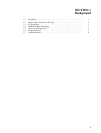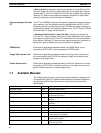
5
The first thing that must be assessed is the number of input and output points
that the controlled system will require. This is done by identifying each device
that is to send an input signal to the PC or which is to receive an output sig-
nal from the PC. Keep in mind that the number of I/O points available de-
pends on the configuration of the PC. Refer to
3-3 Internal Relay (IR) Area
for details on I/O capacity and assigning I/O bits to I/O points.
Next, determine the sequence in which control operations are to occur and
the relative timing of the operations. Identify the physical relationships be-
tween the I/O devices as well as the kinds of responses that should occur
between them.
For instance, a photoelectric switch might be functionally tied to a motor by
way of a counter within the PC. When the PC receives an input from a start
switch, it could start the motor. The PC could then stop the motor when the
counter has received five input signals from the photoelectric switch.
Each of the related tasks must be similarly determined, throughout the entire
control operation.
The actual Units that will be mounted must be determined according to the
requirements of the I/O devices. This will include actual hardware specifica-
tions, such as voltage and current levels, as well as functional considera-
tions, such as those that require Special I/O Units or Link Systems. In many
cases, Special I/O Units or Link Systems can greatly reduce the program-
ming burden. Details on these Units and Link Systems are available in indi-
vidual
Operation Manuals
and
System Manuals.
Once the entire Control System has been designed, the task of program-
ming, debugging, and operation as described in the remaining sections of
this manual can begin.
1-6 Peripheral Devices
The following peripheral devices can be used in programming, either to input/
debug/monitor the PC program or to interface the PC to external devices to
output the program or memory area data. Model numbers for all devices
listed below are provided in
Appendix A Standard Models
. OMRON product
names have been placed in bold when introduced in the following descrip-
tions.
A Programming Console is the simplest form of programming device for OM-
RON PCs. Although a Programming Console Adapter is sometimes re-
quired, all Programming Consoles are connected directly to the CPU without
requiring a separate interface. The Programming Console also functions as
an interface to output programs to a standard cassette tape recorder.
Various types of Programming Console are available, including both
CPU-mounting and Handheld models. Programming Console operations are
described later in this manual.
A Peripheral Interface Unit is required to interface the GPC to the PC.
The GPC also functions as an interface to output programs directly to a stan-
dard cassette tape recorder. A PROM Writer, Floppy Disk Interface Unit, or
Printer Interface Unit can be directly mounted to the GPC to output pro-
grams directly to an EPROM chip, floppy disk drive, or printing device.
LSS is designed to run on IBM AT/XT compatibles to enable nearly all of the
operations available on the GPC. It also offers extensive documentation ca-
pabilities.
Input/Output Requirements
Sequence, Timing, and
Relationships
Unit Requirements
Programming Console
Graphic Programming
Console: GPC
Ladder Support Software:
LSS
Peripheral Devices Section 1-6


















